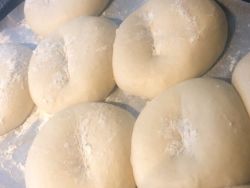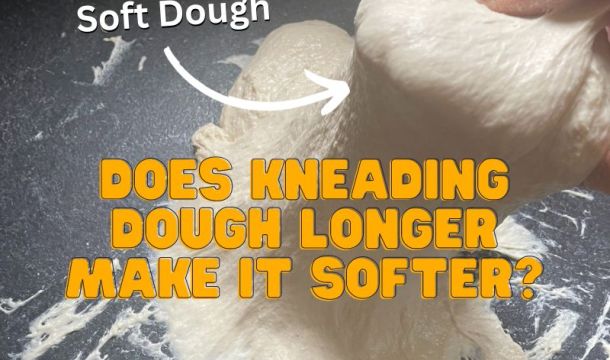
Can You Add More Flour To Dough After It Rises

What is quite beautiful about bread making is that it only requires four ingredients; flour, water, salt and yeast. Anything else added is done so for added flavour or textural improvements. One of the biggest challenges when it comes to making bread, especially at the beginner stages is getting the dough hydration correct. Is it too wet, too dry? One of the most common reflexes when bread dough is sticky is to add more flour to it. This can (arguably) be done during the kneading process, but is it the right thing to add more flour to dough after it rises? Let me help you find the answer!!
Can you add more flour to dough after it rises?
Yes, but the real question is should you do it? When dough is sticky it is tempting to add flour to soak up the excess moisture but this is not recommended. Any raw flour incorporated in the dough will wreck the beautiful gluten structure you aim to seek. The extra flour will have to be kneaded into the dough which will push out all of the gas that exists in the dough. There are several reasons why this is not helpful to the bread:
- The yeast can run out of food, causing the bread to not rise fully and end up dense.
- Raw flour interferes with the gluten structure, making it harder for the dough to rise and lacking a defined structure.
- Raw flour tastes bitter and looks grey and unpleasant.
- Extra kneading incorporates more oxygen which could destroy flavour and aroma through over-oxidation.
When can you add more flour to dough after kneading?
You can add some extra flour after the dough has finished being kneaded. To do this, just add a couple of tablespoons as soon as you feel you need to. This however breaks one of the golden rules of bread baking so isn’t recommended. It’s much better to utilise another method for dealing with sticky dough such as storing it in the fridge and extending fermentation.
Why dough is sticky?
The simplest reason for needing to fix a sticky dough is too much water was added. But there can be more to it than a dodgy recipe. Let’s take a look.
Ingredients not weighed accurately
If you are measuring your ingredients in cups, you’re not going to have the most accurate results. This can lead to too much of the wet ingredients and not enough of the dry. To counteract this, always use scales to weigh your ingredients in grams. The KD7000 scales from MyWeigh are the ones I recommend. They are accurate and really ergonomic when it comes to dividing larger batches of dough.
The flour used is not as absorbent
Different flours absorb varying rates of water. This can change between types (high protein flour absorbs more water), brands and even from irregularities between batches of flour. When trying a new recipe or flour, a handy suggestion is to hold back 10% of the water when you first start kneading. You can add it as and when you require it.
Not enough salt in the dough
Salt binds the gluten together making the dough stronger. If you try to reduce the amount of salt in the dough it will become weak, less elastic and sticky. Aim to use 2% salt to the total weight of the flour.
High humidity
A moist environment leads to more water being absorbed into the dough. It also means less can escape as the bread rises, making the dough more sticky and hard to work with.
The proofing temperature is too warm
If dough is proofed at a too high temperature it is likely to excrete water as it rises which makes the dough sticky. See is the best temperature to proof bread post.
A quick dough needs less water
Quick-bread recipes are ones that encounter a single rise and rise in under 2 hours. Here, the dough rises through aerobic respiration which produces water alongside carbon dioxide. This means that a relatively stiff dough should be prepared to prevent it from getting sticky during the rise.
How to handle sticky dough after it is kneaded
I discussed whether to add flour when kneading dough as a sensible solution to sticky doughs in another post. The short answer is no, not unless you do it right at the start of kneading, and even then it is not ideal for a strong gluten structure.
The best methods to deal with a sticky dough after kneading, avoid folding raw flour into the dough. Here are a few tricks I use when the dough is a bit wet and sticky:
- Wet your hands when working with wet dough to stop the dough from sticking to your fingers.
- When doing stretch and folds or shaping, rub a bit of olive oil onto the work surface before decanting the dough from the container. This acts as a barrier between the table and the dough which makes it much easier to work with.
- Extend the bulk fermentation time to promote more strength from the gluten. To do this, store the dough in the fridge and add some extra stretch and folds
- Use rice flour or coarse semolina combined with wheat flour to heavily line bannetons or bread-proofing baskets.
- Avoid using brotform (compressed cardboard) proofing baskets as if they get dough stuck to them they are a nightmare to clean!
- Whilst it’s not helpful to fold raw flour into the dough. It can be used on the outside of the dough during shaping. To do this when final shaping, dust an area of the worktop with flour and when you reach the “rough ball” shape, roll it gently in the flour before finishing the rounding.
- Don’t keep the proofing environment too humid. This means avoiding adding hot water to create mist. Instead, just cover it.
How to handle sticky dough after it has risen
- Place the dough in the fridge for 1 hour before tipping out of a banneton and/or scoring. This will help it firm up.
- If you’ve added lots of flour to the banneton or proofing basket, use a brush to remove the excess before scoring. Flour burns on the surface of the bread and seeing overly floured bread is one of my pet peeves!
- Add less steam to the oven at the start of baking. Whilst a little steam is helpful, adding a lot when the bread is already extremely moist can hinder oven spring instead of helping it.
- Turn the oven heat down midway. This enables the benefits of a powerful oven spring at the start of the bake, whilst a cooler baking temperature allows the bread to bake for longer and draws out excessive moisture.
Ending thoughts
You now know if you can add more flour to dough after it rises, what to do to prevent needing to add more flour and how to handle wet bread doughs. What will you be doing differently after reading this? Let me know in the comments below.
If you’ve enjoyed this article and wish to treat me to a coffee, you can by following the link below – Thanks x

Hi, I’m Gareth Busby, a baking coach, senior baker and bread-baking fanatic! My aim is to use science, techniques and 15 years of baking experience to make you a better baker.
Table of Contents
Related Recipes
Related Articles
Latest Articles
Baking Categories
Disclaimer
Address
53 Greystone Avenue
Worthing
West Sussex
BN13 1LR
UK








Leave a Reply